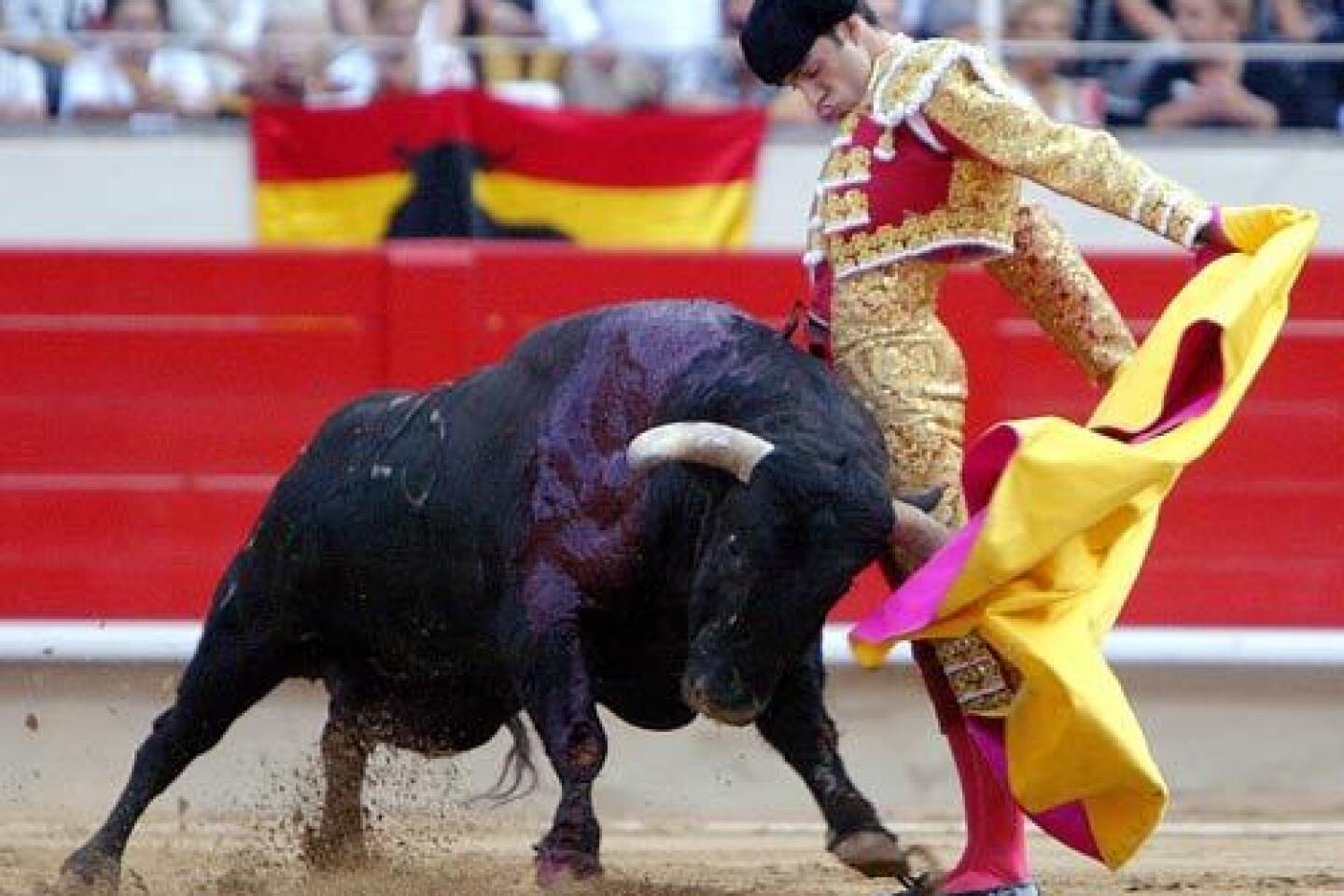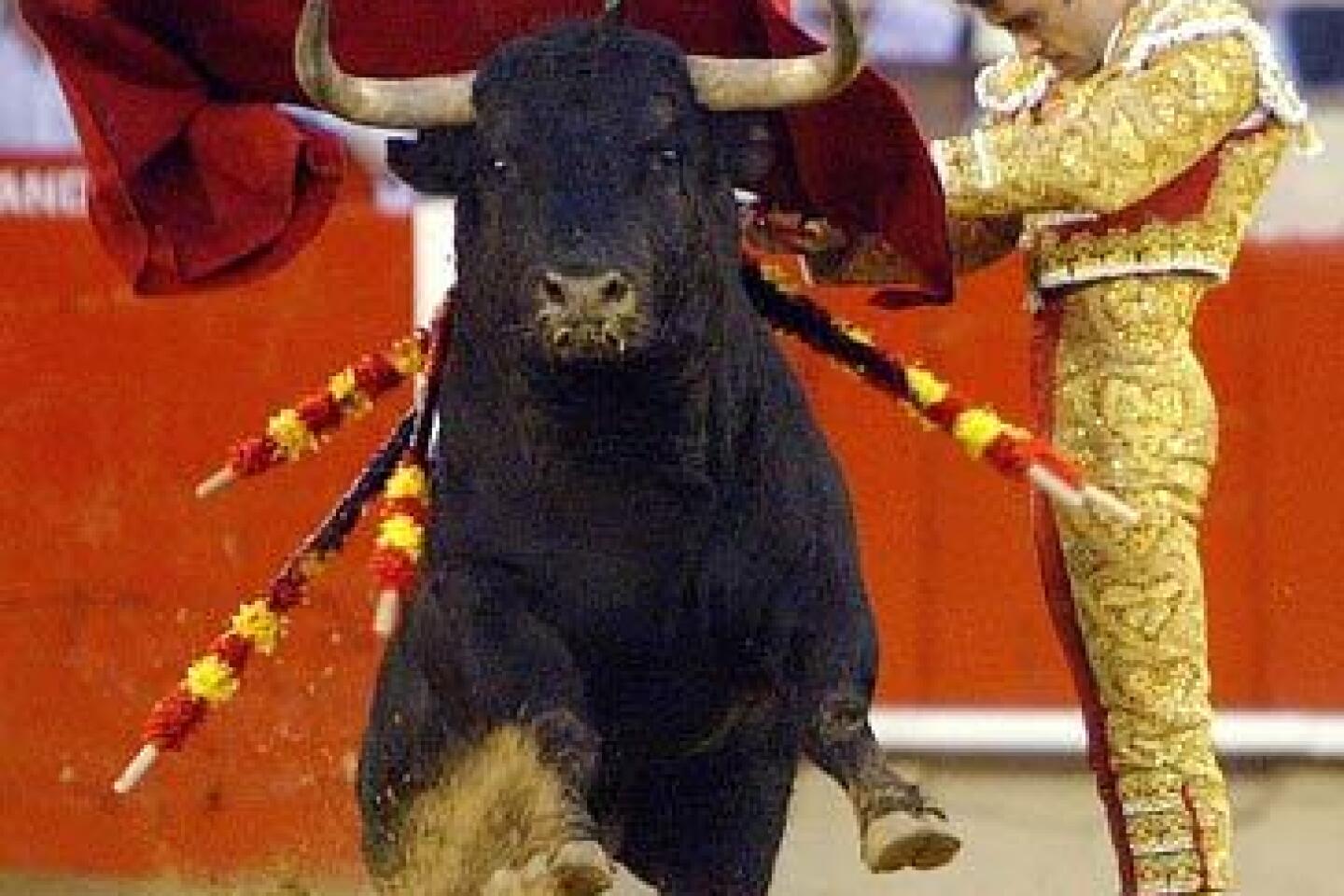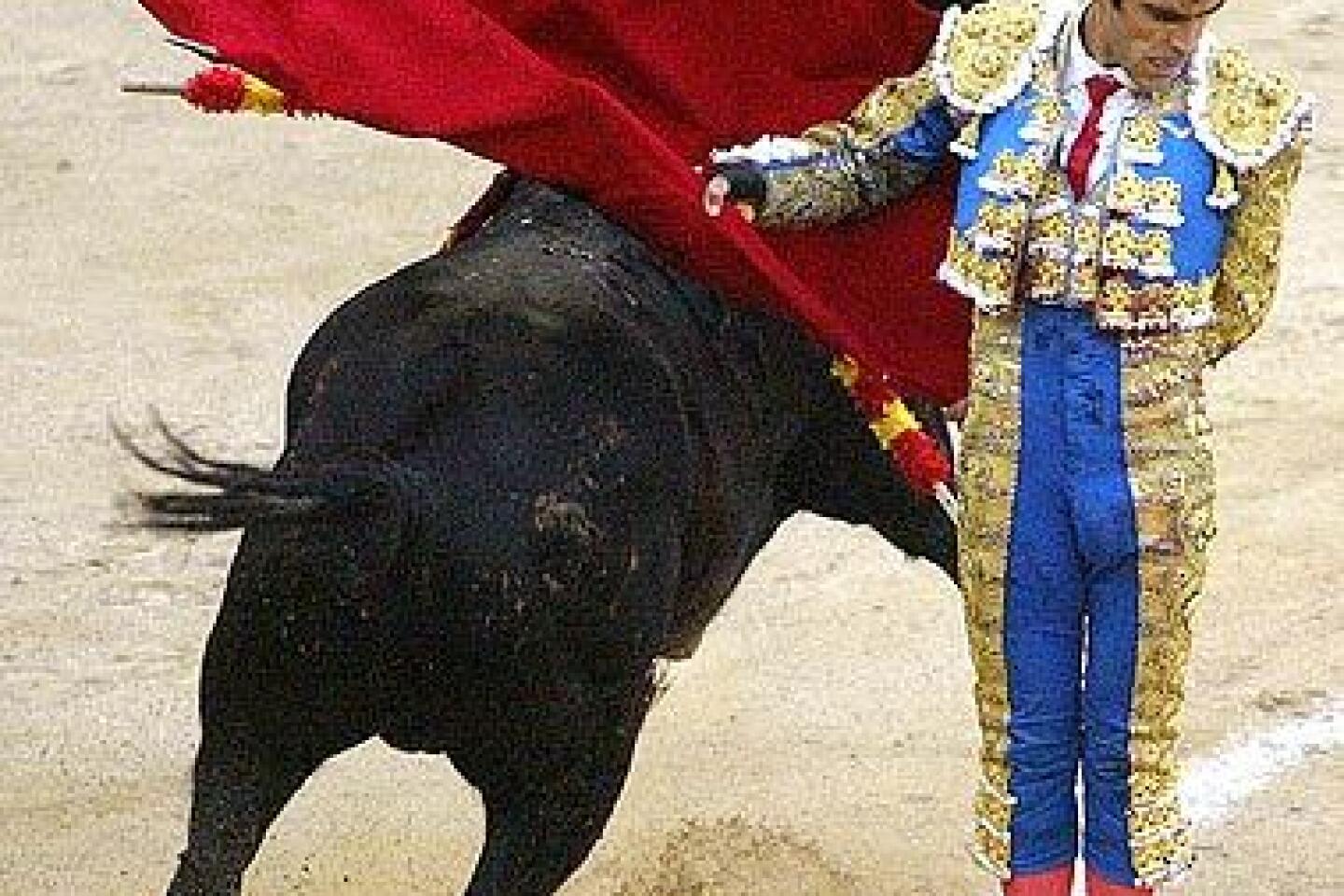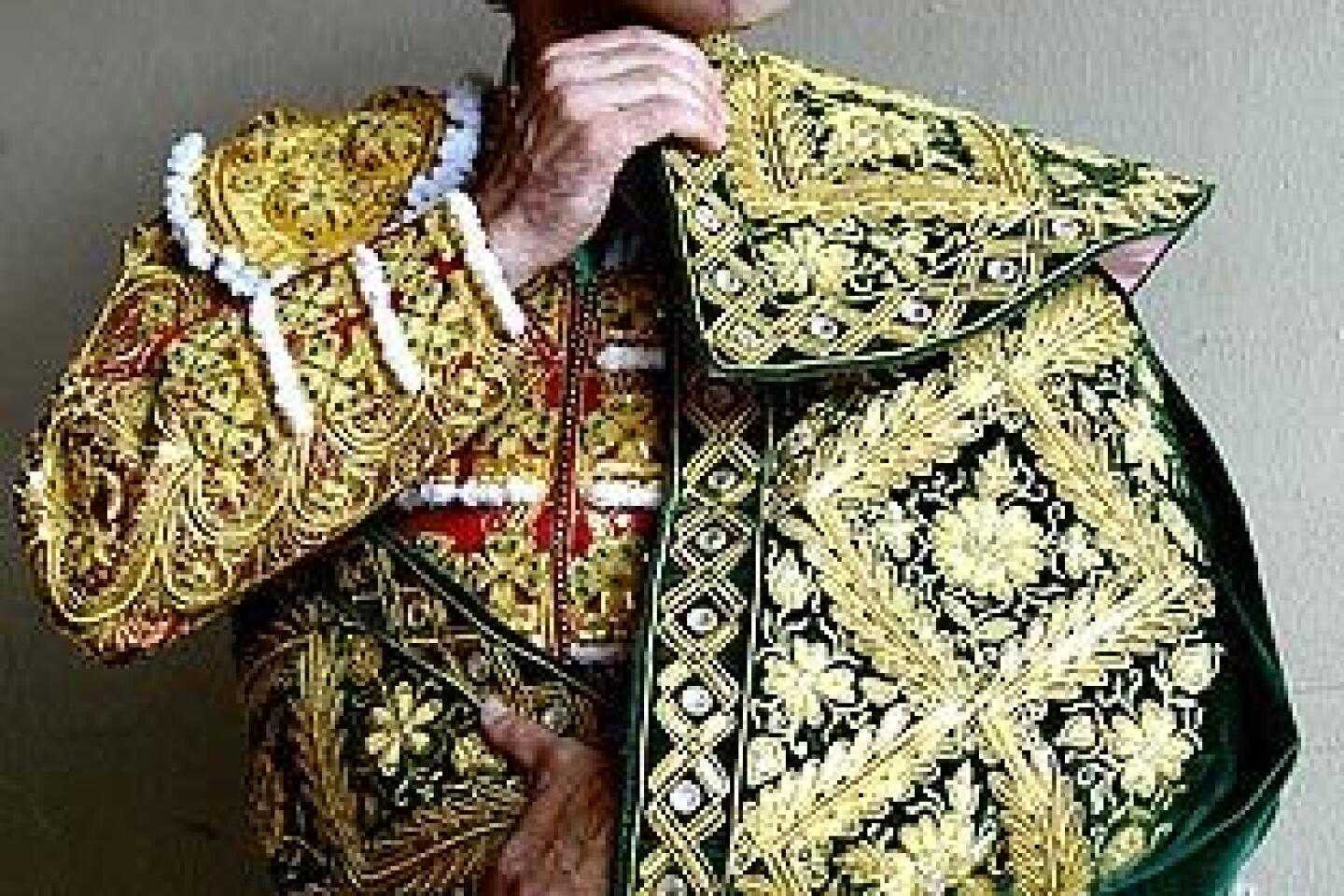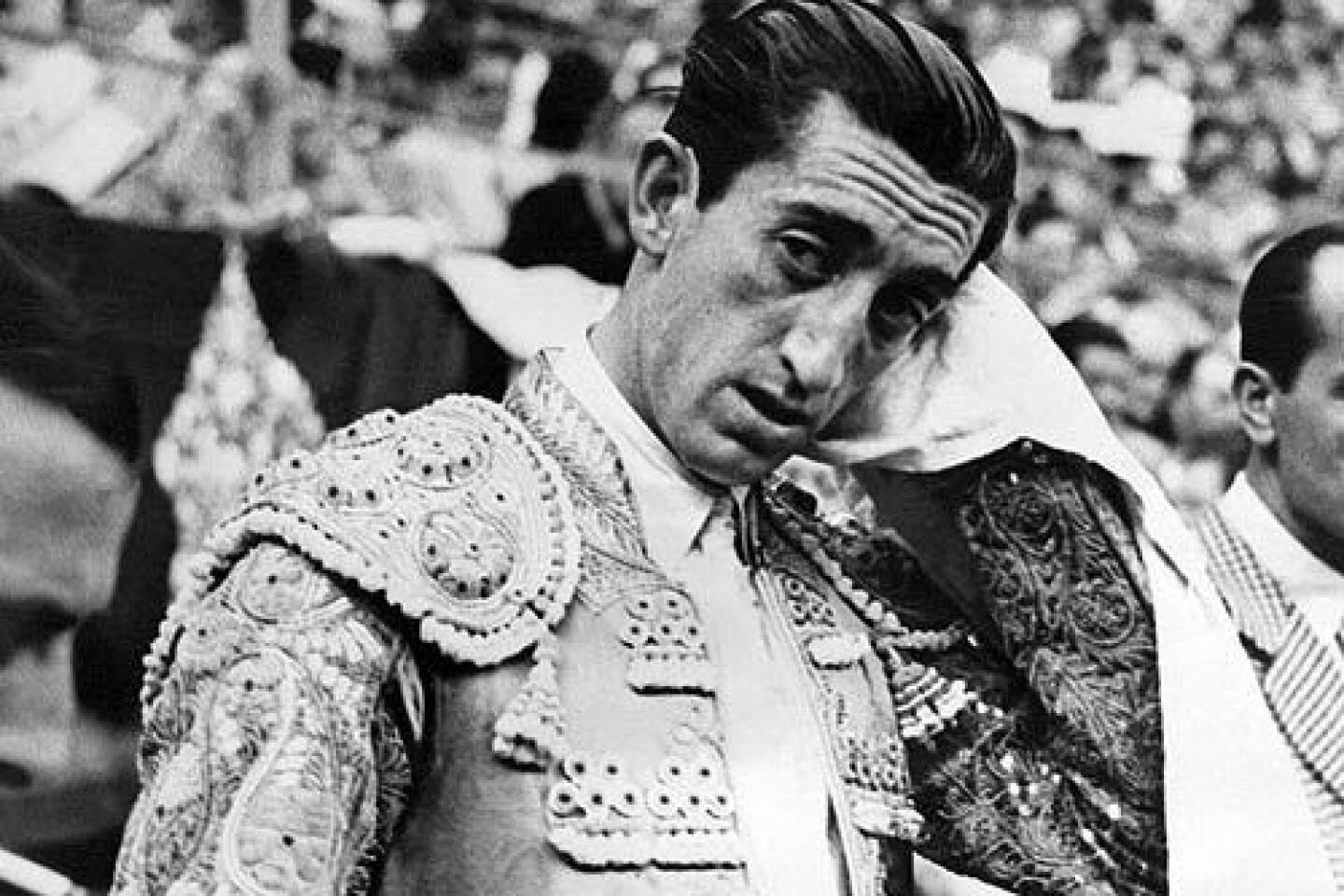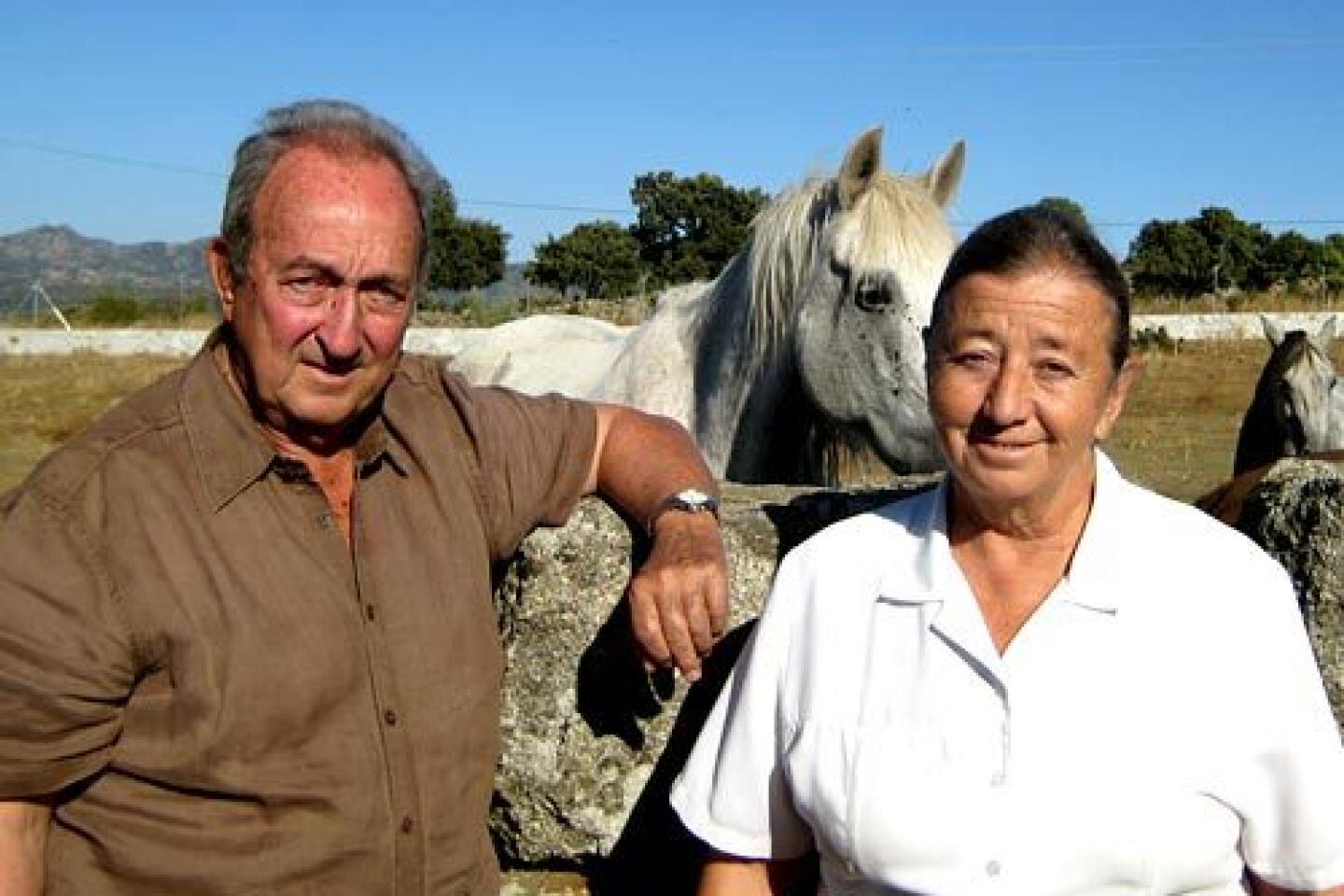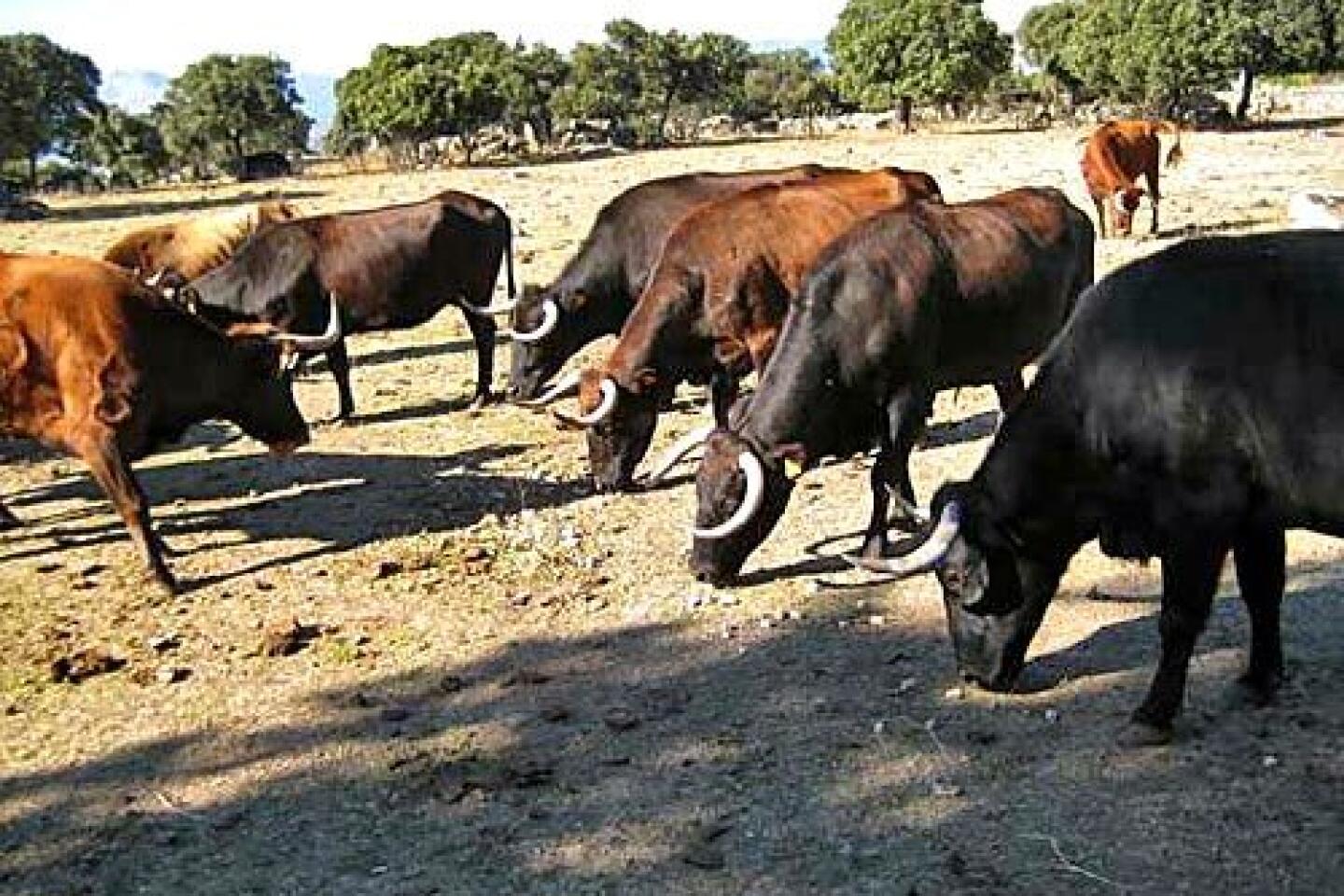In Spain, bullfighting charges back to life
Galapagar, Spain
Angostura, hulking and black, with the number 12 branded into his side, probably doesn’t know he’s green.
He is one of Spain’s legendary “fighting bulls,” and his benefits to the environment constitute a new argument used by aficionados to defend bullfighting, a life-and-death pageantry entwined with Spanish national identity and a bloody inspiration through the ages to painters and poets from Goya to Hemingway.
Raising bulls, so the argument goes, preserves hundreds of thousands of acres of Spanish land that would otherwise fall victim to ugly condos and wasteful golf courses.
Blasted by animal lovers as cruel, frowned upon by the young and hip in the new, dynamic Spain, bullfighting had been in decline in recent years. Until now.
It seems a couple of things have happened on the way to the plaza de toros.
A European Union admonishment to end bullfighting spurred Spaniards who love the controversial sport into action. They organized into committees and began lobbying on its behalf, extolling the ecological virtues as well as the deep-rooted importance of what they call the “national festival” to traditional Spanish culture.
And then, there was Jose Tomas.
This mesmerizing torero has revived interest in bullfighting in ways not seen here in decades.
After an abrupt and unexplained retirement in 2002, the 31-year-old made a dramatic comeback this season to accolades bordering on hysteria. From politicians (of all ideological stripes) to artists, musicians and ordinary fans, Spaniards rejoiced. Half-empty arenas gave way to packed stands.
Spain’s leading pro-left newspaper, El Pais, where reports on bullfights had virtually vanished, once again devoted page after page of coverage -- to Jose Tomas. The state television network, after announcing it would no longer broadcast the spectacle, provided live satellite hook-ups to Tomas’ season-ending appearance late last month in Barcelona.
The adulation has to do with his mysterious allure and what aficionados see as unparalleled bravery and artistry. Tomas manages to evince an air of commanding calm, even when he’s been gored and is bleeding profusely, struggling not to pass out.
Conjuring the ghost of his idol Manolete, considered possibly the greatest matador of all time, Tomas performs in near slow-motion, poised ramrod-straight within striking distance of the bull’s razor-sharp horns, seemingly in a trance. Fans and commentators use words like “messiah,” “king” and “epic” to describe his performance, his challenge to and domination of the half-ton beast he faces on the arena’s sandy floor.
Enhancing the mystique, Tomas, with his dark wavy hair and imposing square jaw, rarely speaks in public; the only glimpse of his private life came splashed in a couple of recent celebrity magazines that caught photos of him on the beach with his heretofore unknown girlfriend. He is smiling and his body is slender, the gash from one of his run-ins with a bull clearly visible on his right thigh.
Tomas deliberately chose to make his return in Barcelona, where anti-bullfighting sentiment is especially strong. It was the first Spanish city, in 2004, to formally condemn the activity (though it would take the regional government to actually ban it) and has outlawed attendance by children under 14. Protests outside bullrings are common.
Tomas’ debut in Barcelona’s Monumental Plaza de Toros (a venue on the verge of being shut down last year because of lack of attendance) was sold out. The audience of 20,000 was sprinkled with Spanish A-list celebrities and officials, who roared a sustained chorus of “Ole!” as Tomas, seemingly oblivious to danger, repeatedly provoked charges from the bull.
Dressed in turquoise and gold and wielding a red cape, the returned master was at one point thrown to the ground by the beast he faced. But he recovered, killed that bull and then another one, and declared victory. The jubilant crowd showered him with flowers and cheers.
Bullfighting is an acquired taste, and certainly not for everyone. Its attraction is unfathomable to many outsiders, and to more than a few Spaniards as well. A poll last year showed only a quarter of Spaniards had any interest in the ritual, which has existed on the Iberian peninsula, in one form or another, for 2,000 years.
The invading Moors of North Africa formalized it in the 8th or 9th century, and for the last few hundred years, bullfighting has not changed substantially. The season today lasts from March to October, with an estimated 2,000 events involving the killing of at least 12,000 bulls.
For many, the ritual is nothing more than the slow torture of an animal, which is taunted, made to bleed and then killed for the pleasure of a cheering crowd.
Animal rights advocates and other critics say the bullfighting industry institutionalizes, subsidizes and encourages cruelty, and creates a national, generalized tolerance of brutal abuse of animals.
“Only in Spain is the phrase ‘You are a good killer’ -- Eres un buen matador -- a compliment,” said anti-bullfight crusader Arturo Angel Perez.
But bullfighting advocates, who include patrons as powerful as the king of Spain, point to the detailed choreography, costumes that include flamboyant suits embroidered in gold and sequins, and music such as the trumpeted paso doble, all of which combine to create what they regard as a unique art form.
A brilliant matador “is like a sculptor who is molding, not clay, but the animal,” said Isabel Carpio, secretary-general of the 102-year-old Union of Fighting Bull Breeders and a veterinarian. She said she sees beauty, not pain and suffering, in the ring.
The ritual, and all that goes into it, is also a $2-billion industry that employs 70,000 people, the union says.
Each year, a few dozen bulls are spared if they put up an especially brave fight. The meat is also considered a delicacy.
Here in Galapagar, which also happens to be Tomas’ hometown, Juan Jose Rueda and his wife, Luisa Parache, have been raising fighting bulls, or toros de lidia, as the race is called, for generations. The ranch has been in their family for a couple of centuries.
Rueda remembers Jose Tomas as a child. When the matador was about 11, standing not much taller than the bulls he would confront, he’d come to Rueda’s practice bullring and spar with the cows (which have horns almost as menacing as the bulls’). Young bulls and cows are run through the paces of the corrida to determine their ferocity; the best of the cows are chosen to reproduce.
Even as a boy, Tomas was stoic and composed, Rueda recalled.
“As a person he is introverted, but in the expression of his tauromachy [the art and technique of bullfighting], he is exceptional,” Rueda said. “Revolutionary.”
Angostura, the #12 bull, is one of Rueda’s breeding studs. He’s used to impregnate dozens of cows, which give birth to bulls, the best of which will be sent to bullrings, and almost certain death, when they are about 4 years old. The bulls are bred specifically for the fight, with husbandry techniques befitting racehorses and computerized records of lineage.
Rueda’s ranch, 30 miles northwest of Madrid, stretches for about 250 acres over boulder-strewn pastures of oak and ash trees. He has 220 cows, which roam more or less freely, munching on acorns, caring for their young and coexisting with wildlife such as boars and birds.
The soil-poor land would not be suitable for crops, Rueda said, and he is convinced that were it not for the livestock, the land would be overrun with tens of thousands of condos, like the ones that have sprung up on all sides of the once-remote ranch. Rueda and Parache routinely have to eject trespassers who jump the fences and wander onto the ranch, often teens looking for a place to party or people walking their dogs.
“We are surrounded,” said Rueda, 73. “We never have to worry about the bulls getting out but, rather, the people getting in.”
Rueda said he is not bothered by the anti-bullfighting crowd. If they don’t like it, he figures, they don’t have to attend.
The lobbying is left up to people such as Miguel Cid Cebrian, an attorney and former lawmaker for the Socialist Party who is president of the Parliamentary Bullfighting Assn., formed a few months ago to defend and promote the national pastime. The committee includes politicians from the left and right, a rare thing in today’s sharply polarized Spain.
“We are under threat,” he said in his Madrid office, decorated with bronze sculptures and oil paintings of bulls and matadors.
Among the “enemies,” as Cid Cebrian calls them, is the European Parliament, which passed a resolution this year urging Spain to end bullfighting “given that it stresses, exhausts, wounds and/or kills bulls” and because member nations are committed to guaranteeing the humane treatment and well-being of animals.
To counter the controversy, the association is holding seminars and handing out copies of a study that argues (improbably, to most critics) that the bull doesn’t really suffer in the ring because its adrenaline is pumping so fiercely.
Cid Cebrian, 64, hails from the Salamanca region of Spain and grew up around bulls and corridas. He is a real aficionado. But his four university-aged children couldn’t care less, or are repulsed by “the death and the blood,” he said. It makes for contentious family discussions.
“It is true, the bull dies,” Cid Cebrian said. “But he has to die. Like all animals, cows die.
“The bull lives, like a king, for four or five years. He dies in 20 minutes.”
Bulls were indeed dying on a recent Sunday afternoon at Las Ventas, Madrid’s historic bullring.
Amid great fanfare and trumpets, twirling their capes before them, the toreros and their entourages of picadors and banderilleros swept into the arena, pawing at the dirt’s edge with their fuchsia-stockinged feet, much as the bulls eventually would do.
The day’s first matador, 21-year-old Agustin Espartinas, made the sign of the cross with his two-cornered black hat and then confronted his first bull with a series of broad waves of his cape. As is the custom, in came the picadors on horseback, jabbing the bull with their lances, and then the banderilleros on foot, spearing the animal’s back with ribbon-trimmed barbed sticks.
A couple of times, the bull charged the horses, which wore padding, to the boos of the crowd. Finally, blood pouring from its shoulders, the bull grew weak. Espartinas moved in. He thrust his pelvis and rushed his cape closer and closer to the bull, which by now was staggering, its tongue hanging out. It stubbed its horns in the ground.
Espartinas then used his sword to kill the bull, which fell heavily. Its body was still twitching as the matador sliced off its ear, the ritualistic sign of victory.
Taking it all in, Victoria Caceres, 24, a recent political science graduate, sat in the more expensive sombra, or shaded, section, designer sunglasses perched on her head. She’s been going to bullfights, she said, since she was a child.
“It is a cultural component that comes from times that we no longer even remember,” Caceres said. “It is something that is ours, something intrinsic. It is a world that once you enter, you like it more and more, and you want to be more a part of it.”
Alina Leyva, 61, who lives in Seattle but whose family is from Barcelona, was having none of it. Brought to the ring by her husband and friends, she fled to the outer exit ramp less than half an hour into the event.
“I know parts are beautiful . . . I know it’s tradition, but then I was seeing what they did to the animal,” she said.
“As soon as I saw the blood on the bull, I said, I’m outta here.”
On the same afternoon, at the Monumental Plaza de Toros in Barcelona, Jose Tomas was taking a victory lap on the shoulders of his assistants before a rapturous standing-room-only audience as the season was coming to an end.
Outside, several hundred protesters staged a mock funeral for the bulls killed this last year. In the 21st century, they said, there can be no justification for such “aggression” against an animal merely for entertainment.
But Cid Cebrian said he was confident that no national Spanish government will ever have the nerve to eliminate the cultural fixture that is bullfighting: “It would be suicide.”
Comments? Email [email protected]
Times Rome Bureau chief Wilkinson was recently on assignment in Spain.
More to Read
Sign up for The Wild
We’ll help you find the best places to hike, bike and run, as well as the perfect silent spots for meditation and yoga.
You may occasionally receive promotional content from the Los Angeles Times.
